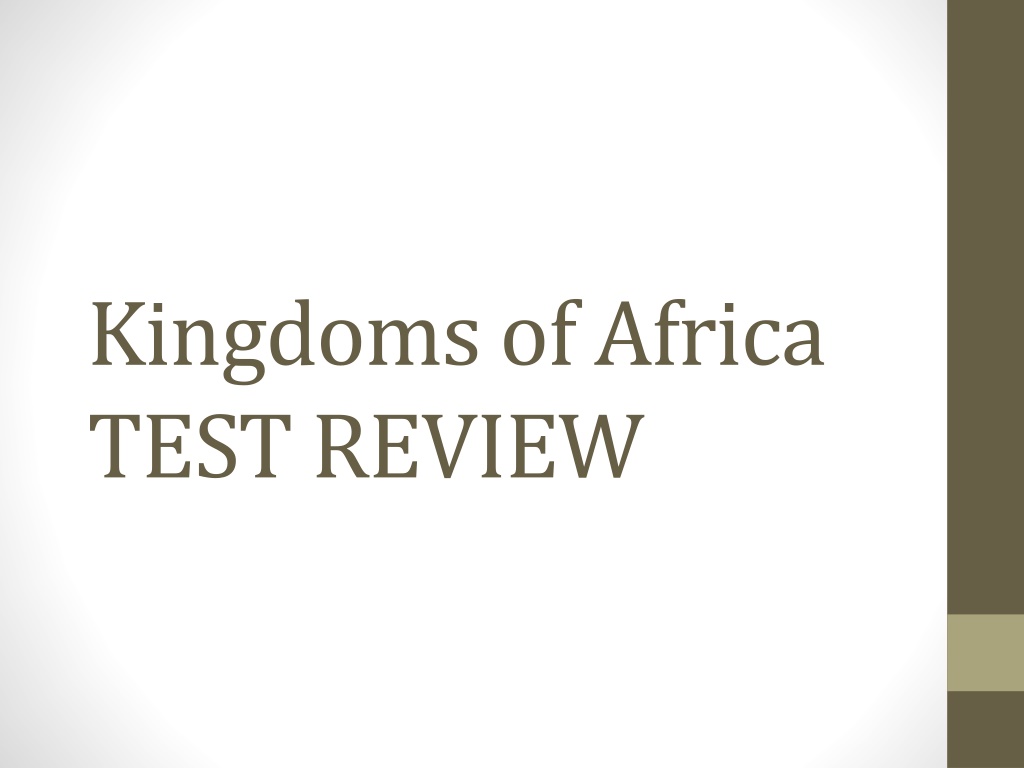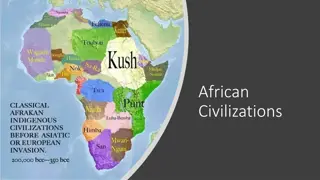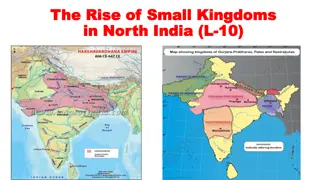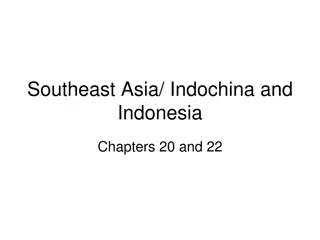Kingdoms of Africa TEST REVIEW
The kingdoms of Ghana, Mali, and Songhai flourished in West Africa, marked by trade, wealth, and cultural exchange. Ghana's iron tools, Mali's conquests under Sundiata Keita and Mansa Musa's famous pilgrimage to Mecca, and the Songhai Empire's dominance are highlighted. However, they faced challenges from North African invasions, disruption of trade routes, and eventual decline. Timbuktu's significance as a trading and cultural center, along with the spread of Islam in the region, are also explored.
Download Presentation

Please find below an Image/Link to download the presentation.
The content on the website is provided AS IS for your information and personal use only. It may not be sold, licensed, or shared on other websites without obtaining consent from the author.If you encounter any issues during the download, it is possible that the publisher has removed the file from their server.
You are allowed to download the files provided on this website for personal or commercial use, subject to the condition that they are used lawfully. All files are the property of their respective owners.
The content on the website is provided AS IS for your information and personal use only. It may not be sold, licensed, or shared on other websites without obtaining consent from the author.
E N D
Presentation Transcript
Kingdoms of Africa TEST REVIEW
Ghana AD 750 -1200 Made iron swords and tools The Kings of Ghana taxed all trade passing through the region, especially the gold-salt trade Rulers and nobles were further enriched by using captives of war as slaves Ghana reached the height of its trading power in the 800s and 900s. Arab Traders and Berber Traders involved in the salt and gold trade brought Islam to Ghana. Around AD 1100 Invaders from North Africa (Morocco) disrupted trade routes and weakened Ghana.
Mali 1240 -1400 A weakened Ghana lead to the rise of Mali. AD 1200 s Mali conquered Ghana. Sundiata Keita, the Lion Prince was the man who united the kingdom of Mali. Sundiata Keita expanded the territory of Mali, including the city of Timbuktu. Mansa Musa was another prominent leader in Mali Mansa Musa is most well known for his Hajj to Mecca
Mansa Musa (Mali) Mansa Musa expanded kingdom greatly Made a religious pilgrimage (hajj) to Mecca traveled with HUGE amounts of gold; 80 camels needed to carry supplies Brought Muslim scholars and architects back to Mali with him (from Mecca) Mecca is a religious holy city for Muslims Muslim scholarship flourished Mansa Musa allowed different religions, but worked to strengthen Islam.
Mansa Musa (Mali) (in-depth) The hajj is a pilgrimage A pilgrimage is a journey or search of moral or spiritual significance. Typically, it is a journey to a shrine or other location of importance to a person's beliefs and faith. Many religions, including Christianity, Judaism, and Islam believe in going on pilgrimages. Mansa Musa s hajj became so well known because of the way he traveled. Mansa Musa traveled in grand style. Eighty camels carried two tons of gold. Mansa Musa gave away so much gold to the poor on his journey that the price of gold fell. While in Makkah (Mecca), Mansa Musa met scholars of Islam. He convinced them to return with him to Mali. They helped spread Islam in West Africa.
Timbuktu Famous TRADING city CULTURAL Center Center for ISLAMIC STUDY and Scholarship
Songhai 1464 1600 Mali weakened after the death of Mansa Musa in 1337 The weaken empire allowed Sunni Ali to take control and create the Songhai empire. Sunni Ali gained control of Timbuktu and used the Niger river to expand the Songhai empire. The Songhai empire became the largest empire in West Africa. The Songhai empire thrived until AD 1600 when it was invaded by North Africans.
Bantu Migrations Bantu Migrations The Bantu people migrated throughout Africa over hundreds of years. These migrations spread the Bantu language, culture, and technologies such as farming and iron-working skills. Bantu villages were matrilineal. This means ancestry is traced through mothers, not fathers.
African Society Family was the basis of African society Extended families families made up of several generations Children Children were educated in their local village. Griots often played a part in education because they were responsible for passing on the oral history of the village. African Art Rock paintings, woodcarvings, masks, and statues were early forms of African art. Music and Dance were often used to celebrate important events Enslaved Africans used music to remind them of their homeland























